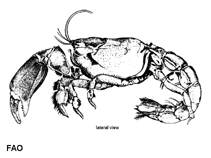Thalassina anomala (Herbst, 1804)
Scorpion mud lobster| Native range | All suitable habitat | Point map | Year 2050 |

|
| This map was computer-generated and has not yet been reviewed. |
| Thalassina anomala AquaMaps Data sources: GBIF OBIS |
Classification / Names Common names | Synonyms | CoL | ITIS | WoRMS
Malacostraca | Decapoda | Thalassinidae
Environment: milieu / climate zone / depth range / distribution range Ecology
Benthic; brackish. Tropical; 31°N - 24°S, 73°E - 169°W (Ref. 4)
Distribution Countries | FAO areas | Ecosystems | Occurrences | Introductions
Indo-Pacific.
Length at first maturity / Size / Weight / Age
Maturity: Lm ? range ? - ? cmCommon length : 30.0 cm TL male/unsexed; (Ref. 4)
Short description Morphology
The integument of the body is very firm. The carapace is high; in dorsal view it is elongate oval in outline. In adults the carapace measures less than 1/3 of the total body length. The rostrum is narrowly triangular and short; it is depressed and its lateral margins continue for some distance on the carapace as short divergent ridges. The rostrum has no teeth. The carapace ends posteriorly in a distinct posteriorly directed median tooth that overhang the articulation with the first abdominal somite. The abdomen is long and narrow, more than 5 times as long as wide in the males, about 4 times as long as wide in the females. The somites are of about equal width throughout their length they have a longitudinal carina over the base of the pleura. The telson is about as long as the previous somite, but slightly narrower, the posterior margin is broadly rounded. The uropods are styliform. The eye are small. The first pair of pereiopods is very strong and assymetrical, both chelae and subchelate, the larger less conspicuously so than the smaller. The second legs are smaller, also subchelate; the other legs are simple. Epipods are present on the pereiopods. Colour: the whole body is rather uniformly yellowish or reddish brown (Ref. 4).
It has a total body length of 16 to 30 cm (Ref. 4). It lives in the littoral and supralittoral zones, where it digs its burrows. It is found in mangrove areas and estuaries; the excavated mud forms a kind of chimney or mound over the openings of the burrows, and because of their height form a most conspicuous feature in the landscape. The chimneys can be 75 cm high, but sometimes several chimneys together can form complex hills of mud up to 1.5 m high. The burrows go down vertically or obliquely to the water level after which they make zigzags and side branches; the depths of the burrows has been estimated to be up to 2.5 m. They are rarely seen out of their burrows, not even at night, but it seems that after heavy rainfall they may venture outside. They are sluggish and are definitely mud feeders. Their burrowing activities usually take place at night (Ref. 4).
Life cycle and mating behavior Maturity | Reproduction | Spawning | Eggs | Fecundity | Larvae
Members of the order Decapoda are mostly gonochoric. Mating behavior: Precopulatory courtship ritual is common (through olfactory and tactile cues); usually indirect sperm transfer.
Main reference
References | Coordinator | Collaborators
Holthuis, L.B. 1991. (Ref. 4)
IUCN Red List Status (Ref. 130435)
CITES status (Ref. 108899)
Not Evaluated
CMS (Ref. 116361)
Not Evaluated
Threat to humans
Human uses
Fisheries: minor commercial
| FishSource |
Tools
More information
Internet sources
BHL | BOLD Systems | CISTI | DiscoverLife | FAO(Publication : search) | Fishipedia | GenBank (genome, nucleotide) | GloBI | Gomexsi | Google Books | Google Scholar | Google | PubMed | Tree of Life | Wikipedia (Go, Search) | Zoological Record
Estimates based on models
Price category
(Ref. 80766):
Unknown.



